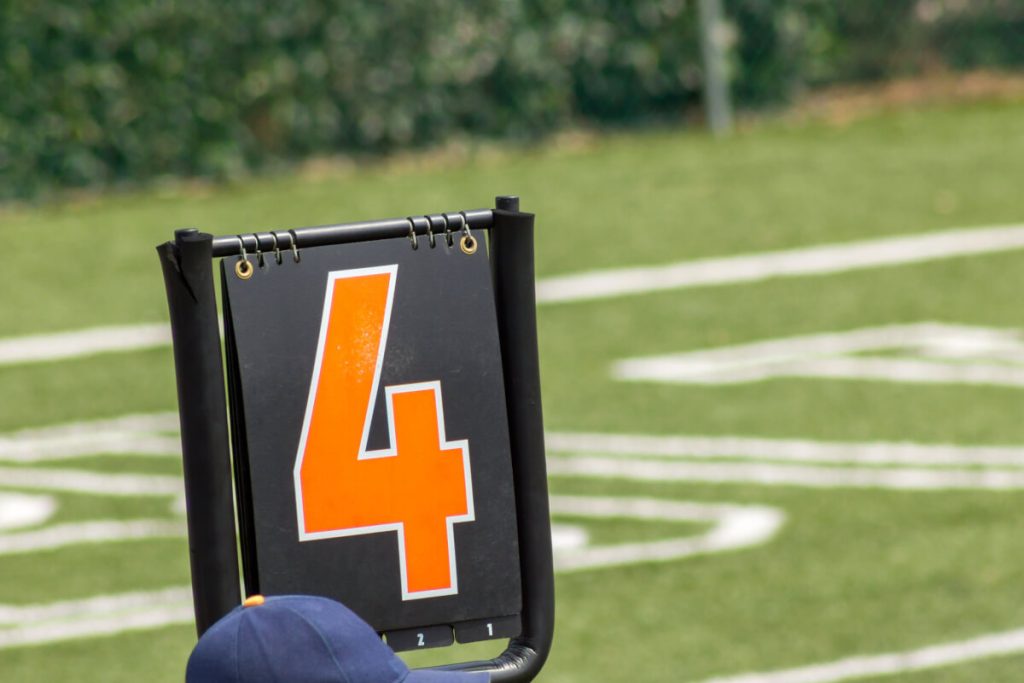

(Photo by Suriel Ramzal on Shutterstock)
Study shows NFL coaches get cold feet when stats say to go for it
PROVO, Utah — The National Football League runs on data. Teams track everything from player speed to ball rotation, yet when it comes to fourth down decisions, coaches routinely ignore what the numbers tell them to do. With millions watching, especially during high-stakes games like the Super Bowl, these high-pressure calls can mean the difference between winning or losing. A new study reveals why coaches consistently play it safe when the numbers suggest they should be more aggressive.
The mathematics of football suggest that teams should be more aggressive on fourth down than they typically are. A field goal attempt from 45 yards out might seem like the safe choice, but analytics show that going for it often provides better odds of ultimately winning the game. Despite this evidence, coaches consistently make more conservative choices than what the numbers recommend.
New research, published in the Annals of Applied Statistics, analyzed thousands of fourth-down decisions across nine NFL seasons (2014-2022) to understand how coaches make these high-stakes calls. Rather than prescribing what coaches should do, the researchers took an innovative “inverse optimization” approach. They assumed coaches’ actual decisions were optimal and worked backward to understand the hidden risk preferences driving their choices.
“Coaches think about factors beyond just the win or loss of a game,” says lead researcher Nate Sandholtz of Brigham Young University, in a statement. “Reputation, personal experience, and their perception in the eyes of owners, managers and fans all factor into their coaching decisions. Our model accounts for these factors through coach-specific risk parameters.”


When faced with fourth down, coaches have three options: attempt to gain the required yardage for a first down (go for it), try a field goal if close enough to the end zone, or punt the ball away. Going for it is considered the riskiest choice since failing gives the opponent excellent field position. A missed field goal has similar consequences, while punting represents the conservative option by giving up possession but typically leaving opponents with worse starting field position (meaning they have to cover more yards to score).
The study revealed fascinating patterns in how coaches make these crucial decisions. One major factor was field position. Coaches behaved very differently depending on which side of the 50-yard line they were on. In their own territory, where a failed attempt would give opponents an immediate scoring opportunity, coaches showed extreme caution. However, once they crossed midfield into opponent territory, their risk tolerance increased significantly.
This field position effect persisted across virtually all game situations. Even when trailing late in games, coaches remained notably conservative in their own territory. Only when facing very low win probabilities (below 20%) did coaches begin matching the aggression levels recommended by analytics models, and even then, primarily in opponent territory.
The research also documented how fourth-down decision-making has evolved over time. Early in the study period (2014-2015), coaches were overwhelmingly conservative, rarely deviating from traditional punting and field goal attempts except in desperate situations. By the end of the study (2021-2022), coaches had become markedly more aggressive, though still not reaching the levels suggested by win probability models.


“In general, NFL coaches are trending towards the optimal behavior that we estimate in statistical models,” Sandholtz notes. “It’ll be interesting to see if the risk tolerances we estimated for Reid and Sirianni play out in Sunday’s game [Super Bowl LIX].”
What does this mean for Super Bowl LIX? This Sunday, the Philadelphia Eagles face the Kansas City Chiefs in a championship rematch. The study’s analysis of coaching tendencies shows a stark contrast between head coaches Nick Sirianni and Andy Reid’s fourth-down philosophies. Among the 85 coaches analyzed, Sirianni ranked sixth in risk-taking, frequently making aggressive fourth-down calls, especially in opponent territory. Reid, despite his reputation for offensive creativity, placed in the middle of the pack for fourth-down risk tolerance, typically favoring more conservative choices.
These patterns suggest Eagles fans may see more aggressive fourth-down attempts from Sirianni, while Reid’s Chiefs are likely to take a more measured approach, particularly in their own territory. The contrasting styles of these coaches could become a decisive factor, especially in a closely contested game where fourth-down decisions often mean the difference between winning and losing.
In general, coaches who displayed high risk tolerance early in their careers generally maintained that approach, while conservative coaches rarely became more aggressive unless facing desperate circumstances.
The findings also suggest that even in high-stakes professional environments, decision-makers are influenced by factors beyond pure win probability. The persistence of conservative choices, even when more aggressive options offer better odds of success, reflects how organizational and career pressures can affect strategic decisions.
Modern NFL teams employ extensive analytics departments and have access to sophisticated statistical models. Yet this research shows that having better information doesn’t automatically change decision-making patterns. Coaches must balance analytical recommendations against various other factors, such as team strengths and weaknesses, weather conditions, player fatigue, and their own job security.
As NFL teams continue investing in analytics, the gap between statistical recommendations and coaching decisions may narrow. However, this research demonstrates that pure mathematics cannot capture all factors influencing critical game decisions. These persistent patterns suggest that human judgment will remain crucial in fourth-down decisions, regardless of what the numbers recommend.
Paper Summary
Methodology
The researchers used detailed records of every play from NFL games to create a mathematical framework showing how fourth-down decisions influence game outcomes. They developed a model considering factors like field position (distance from scoring), yards needed for first down, and how each decision affects the rest of the game to estimate the true risk and reward of each option.
Results
The analysis found that NFL coaches generally prefer safer options compared to what statistical models recommend. Coaches showed significantly higher risk tolerance when making decisions in opponent territory versus their own half. Risk preferences increased across the league over the nine seasons studied, suggesting a gradual shift toward more aggressive fourth-down strategies.
Limitations
The research focused on readily available situational factors while excluding some contextual elements like weather, injuries, and specific team strengths. The model also treated teams as having equal capabilities rather than accounting for talent disparities that might influence optimal decision-making.
Discussion and Takeaways
The findings suggest that NFL coaches’ famous conservatism on fourth down stems from genuinely different risk preferences rather than poor decision-making. However, the trend toward increased aggression indicates growing acceptance of analytical approaches. The stark difference in risk tolerance based on field position reveals how psychological factors influence what should be purely mathematical decisions.
Funding and Disclosures
The research was conducted through academic institutions including Brigham Young University, University of British Columbia, and University of Toronto. No external funding or conflicts of interest were reported. Lead author Nate Sandholtz is a statistics professor at Brigham Young University.
Publication Information
“Learning Risk Preferences in Markov Decision Processes: An Application to the Fourth Down Decision in the National Football League” was published in the Annals of Applied Statistics in August 2024. The research team included Nathan Sandholtz, Lucas Wu, Martin Puterman, and Timothy C.Y. Chan.







